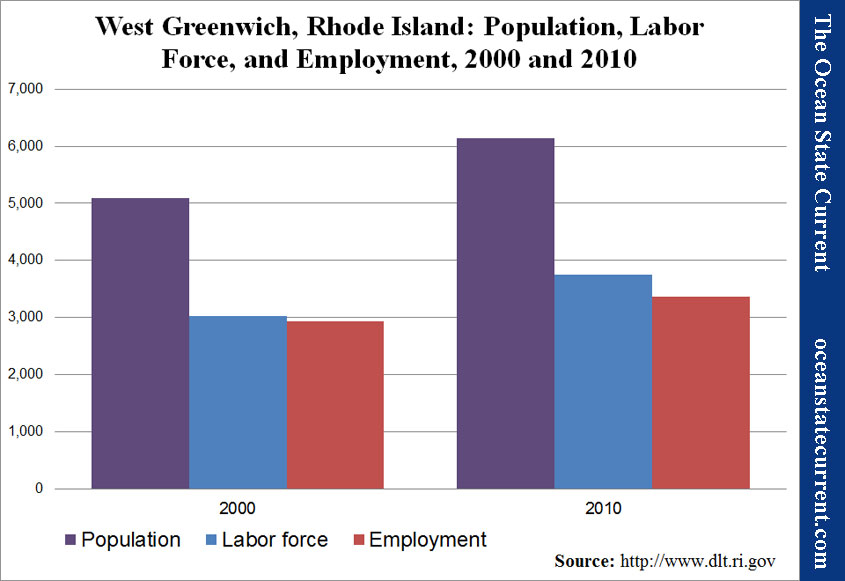State in Decline, Employment in RI Cities and Towns: West Greenwich
When reviewing the employment situation in West Greenwich, it’s extremely important to keep in mind the limitations of the data for such a small population. Assuming the surveys of Rhode Island employment are more or less distributed evenly by population, the model for West Greenwich would be based on fewer than a dozen respondents. That’s a very small sample, and it may explain the large jumps shown in the timeline chart below.
That said, West Greenwich appears to be somewhat unique, in Rhode Island, in that it saw in population (20.6%), labor force (23.7%), and employment (15.1%) from 2000 to 2010. (The population data derives from the decennial U.S. Census, so it is likely more accurate.)
However, despite the growth across categories, the fact that the number of West Greenwich residents want to work (which is its labor force) increased more rapidly than the number who are actually working (employment) means that the town’s number of residents considered unemployed increased, as well. Indeed, the number of unemployed residents of West Greenwich was almost as high, in March 2012, as it’s ever been in the twenty-two years of data on the Department of Labor and Training’s Web site.
That number was a bit higher in March 2010, but the labor force has shrunk, leaving West Greenwich with its highest unemployment rate on the books in February this year, 12.1% (not seasonally adjusted), which matched the unadjusted 12.1% for the state overall. In the following chart, the number of unemployed residents is the distance between the two lines.
It’s interesting to note that, with the exception of the current downslide, West Greenwich’s has been a story of population and employment growth, with a surprisingly consistent unemployment rate.
Note on the Data
The population data above comes from the U.S. Census conducted every ten years and is therefore generally considered reliable, to the extent that is used as reference for various government programs and voter districting.
The labor force and unemployment data, however, derives from the New England City and Town Areas (NECTAS) segment of the Local Area Unemployment Statistics (LAUS) of the federal Bureau of Labor Statistics (BLS). A detailed summary of the methodology is not readily available, but in basic terms, it is a model based on and benchmarked to several public surveys. It can be assumed that the sample rate (i.e., the number of people actually surveyed) in each Rhode Island town is very small (averaging roughly 30 people per municipality).
The trends shown, it must be emphasized, are most appropriately seen as trends in the model that generally relate to what’s actually happening among the population but are not an immediate reflection of it. Taking action on the assumption that the exact number of employed or unemployed residents shown corresponds directly to real people in a town would vest much too much confidence in the model’s accuracy.
Be that as it may, the data has been collected and published, and taken a town at a time, it is relatively easy to digest. So, curiosity leads the Current to see it as the best available data to deepen our understanding of trends within Rhode Island. If the findings comport with readers’ sense of how the towns relate to each other, perhaps lessons regarding local and statewide policies may be drawn. If not, then the lesson will be on the limitations of data in our era of information overload.






